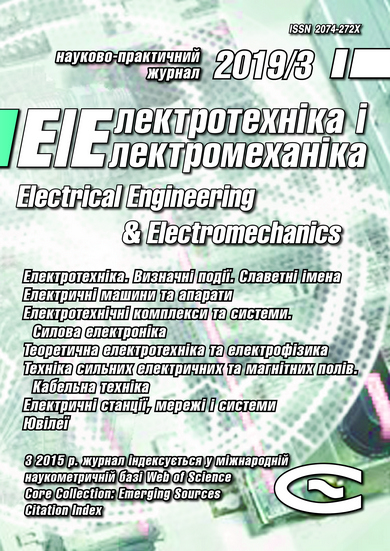PARAMETRIC ANALYSIS AND STRAY FIELDS OF TOROIDAL SUPERCONDUCTING MAGNETIC ENERGY STORAGE
DOI:
https://doi.org/10.20998/2074-272X.2019.3.05Keywords:
superconducting magnetic energy storage, parametric analysis, stray magnetic fieldAbstract
Purpose. To carry out a parametric analysis of superconducting toroidal magnetic systems with a discrete winding, establishing the possibility of using an idealized model in the form of a toroidal current surface and an approximate method for determining the level of fields of scattering of a real magnetic system. Methodology. The calculation of the distribution of the magnetic flux density in the winding, the field of scattering and energy of the storage’s field was carried out using asymptotic methods for solution of the problems of electrodynamics in systems with massive curvilinear conductors with current. An iterative calculation procedure was used to determine the dimensionless characteristics. Results. The dimensionless characteristics of a toroidal magnetic system with a winding in the form of individual superconducting coils of circular shape are calculated. The results are obtained depending on the value of the storage's energy capacity for various values of the relative radial size of the torus. For a toroidal superconducting storage device with energy capacity of 450 MJ, enough to perform the function of damping irregular oscillations of power transmitted over the transmission line, magnetic fields of scattering are calculated for different numbers of coils and torus section sizes. Originality. Based on a comparison of the values of dimensionless characteristics calculated for a system with individual coils, and for an idealized mathematical model of a continuous current surface, it was established that the relative deviation of the dimensionless characteristics does not exceed 10 %. In contrast to the idealized model, the magnetic field of a toroidal system composed of individual coils spreads beyond the toroidal surface and decreases the faster, the smaller the relative radial sectional size of the torus, the greater the number of coils used and the closer they are to each other. Practical value. The results obtained for dimensionless characteristics allow to conclude that the idealized model can be used at the first stage of the development of a superconducting inductive storage. The estimation of the field of scattering can be made on the basis of a simple model of unidirectional current filaments.References
Vyisotskiy V.S., Syitnikov V.E., Yliushyn K.V., Kovalev L.K., Kovalev K.L., Ehoshkyna L.A. Superconductivity in Electromechanics and Power Engineering. Electricity, 2005, no.7, pp. 31-40. (Rus).
Devotta J.B.X., Rabbani M.G. Application of superconducting magnetic energy storage unit in multi-machine power systems. Energy Conversion & Management, 2000, vol.41, pp. 493-504. doi: 10.1016/S0196-8904(99)00100-4.
Matsukawa T., Nakamura H., Nomura S., Sato Y., Tsuji-Ito S., Shimada R. Conceptual design of SMES system equipped for IPP plant. IEEE Transactions on Applied Superconductivity, 2000, vol.10, no.1, pp. 788-791. doi: 10.1109/77.828349.
Thome R.J., Tarrh J.M. MHD and Fusion Magnets. Field and Force Design Concepts. New York, A Wiley-Interscience Publication, 1982. 316 p.
Duchateau J.L., Journeaux J.Y., Gravil B. Tore Supra Superconducting Toroidal Magnetic Field System. Fusion Science and Technology, 2009, vol.56, no.3, pp. 1092-1123. doi: 10.13182/FST09-A9170.
ITER Physics Basis. Nuclear Fusion, 1999, vol.39, no.12. doi: 10.1088/0029-5515/39/12/301.
Avramenko V.M., Aristov Yu.V., Vasetskiy Yu.M., Mazurenko I.L., Chernenko P.O. Some areas of effective use of superconducting magnetic energy storage (SPIN) in power systems of Ukraine. Technical electrodynamics. Thematic issue «Problems of modern electrical engineering», 2008, chapter 3, pp. 43-48. (Ukr).
Zhou X., Chen X.Y., Jin J.X. Development of SMES Technology and Its Applications in Power Grid. Proceedings of 2011 IEEE International Conference on Applied Superconductivity and Electromagnetic Devices. Sydney, Australia, December 14-16, 2011, pp. 260-269. doi: 10.1109/ASEMD.2011.6145115.
Vasetsky Yu.M., Mazurenko I.L., Pavlyuk A.V. Damping of irregular low-frequency load fluctuations using a superconducting magnetic energy storage. Electricity, 2014, no.2, pp. 10-17. (Rus).
Mazurenko I., Pavlyuk A., Vasetsky Yu. Parameters of superconducting magnets with racetrack-shaped coils and support structure placed inside torus. Przeglad Elektrotechniczny, 2012, no.3a, pp. 67-69.
But D.A., Aliyevskiy B.L., Mazyrin S.R., Vasyukevich P.V. Nakopiteli energii [Energy storage]. Moscow, Energoatomizdat Publ., 1991. 400 p. (Rus).
Pavlyuk A. magnetic fields and parameters of toroidal superconducting magnets with limited number of coils. Works of the Institute of Electrodynamics of the National Academy of Sciences of Ukraine, 2013, no.34, pp. 94-105. (Ukr).
Dimitrov I.K., Zhang X., Solovyov V.F., Chubar O., Li Q. Rapid and Semi-Analytical Design and Simulation of a Toroidal Magnet Made With YBCO and MgB2 Superconductors. IEEE Transactions on Applied Superconductivity, 2015, vol.25, no.5, pp. 1-8. doi: 10.1109/TASC.2015.2448455.
Brechna H. Superconducting magnet systems. Berlin, Springer, 1973. 590 p.
Vasetsky Yu.M. Asimptoticheskie metody resheniia zadach elektrodinamiki v sistemakh s massivnymi krivolineinymi provodnikami [Asymptotic methods for solving electrodynamics problems in systems with bulky curvilinear conductors]. Kyiv, Naukova dumka Publ., 2010. 271 p. (Rus).
Downloads
Published
How to Cite
Issue
Section
License
Copyright (c) 2019 Yu. M. Vasetsky, I. L. Mazurenko, S. L. Bondarevskyi

This work is licensed under a Creative Commons Attribution-NonCommercial 4.0 International License.
Authors who publish with this journal agree to the following terms:
1. Authors retain copyright and grant the journal right of first publication with the work simultaneously licensed under a Creative Commons Attribution License that allows others to share the work with an acknowledgement of the work's authorship and initial publication in this journal.
2. Authors are able to enter into separate, additional contractual arrangements for the non-exclusive distribution of the journal's published version of the work (e.g., post it to an institutional repository or publish it in a book), with an acknowledgement of its initial publication in this journal.
3. Authors are permitted and encouraged to post their work online (e.g., in institutional repositories or on their website) prior to and during the submission process, as it can lead to productive exchanges, as well as earlier and greater citation of published work.





